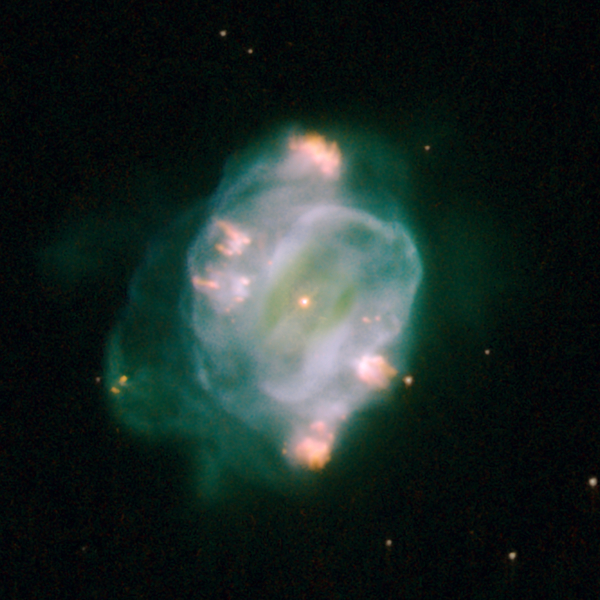NGC 5286 and NGC 5307 in Centaurus
April 2023 - Nebula and Cluster of the Month
We remain in the southern skies for April, being banished from more northerly declinations by the great sweep of the Virgo galaxies.
This month we’re looking at a cluster and a nebula – globular and planetary respectively, that lie just 44’ apart in the constellation of Centaurus.
We’ll start with NGC 5826, a class V globular cluster which shines at magnitude 7.4. It lies about ⅓ of the way along the line joining ε and ζ Centauri, right next to a 4.6 magnitude orange-yellow star known as M Centauri.

NGC 5826 was first catalogued (as Δ388) in 1827 by James Dunlop (1793 – 1848), a Scottish astronomer working from Australia. It is a class V globular cluster, on the concentration scale with I as the most compressed and XII as the loosest (contrary to the misprints in the first edition of the Deep-Sky Field Guide to Uranometria, which would have it the other way round).
The globular cluster lies at a distance of approximately 9,300pc (35,000 light-years) and is one of at least eight that were inherited by the Milky Way when it consumed the dwarf Gaia-Enceladus-Sausage galaxy (yes, seriously, that’s what it’s been called) around ten billion years ago. This merger, the most recent major one, was vital in the evolution of the Milky Way, transforming the Galaxy from a metal-poor, thin-disc galaxy to a thick-disc galaxy, with dust from the dwarf galaxy triggering a new wave of star formation. Most of the metal-rich material in the halo of the Milky Way was donated by the Gaia-Enceladus-Sausage.
The material gained from the merger is now spread all around the galaxy, as demonstrated particularly by the distribution of globular clusters. Globulars that have been identified as likely coming from the Gaia-Enceladus-Sausage are M2 (Aquarius), M56 (Lyra), M75 (Sagittarius), M79 (Lepus), NGC 1851 (Columba), NGC 2808 (Carina), NGC 2298 (Puppis) and NGC 5286. Of all of them, NGC 2808 is by far the most massive, containing about a million stars. It may be that NGC 2808 is the core of the old galaxy.
Visually speaking, NGC 5286 is bright, with an overall magnitude of 7.4 making it an easy binocular target. It is variously quoted as having a diameter of between 9’ and 11’. The brightest star is magnitude 13.5. Brighter stars are projected against the cluster, and the triple star comprising three 12th magnitude stars in the centre of the cluster is not a member.
44’ away from NGC 5286, slightly north of east, lies our second object, the planetary nebula NGC 5307. Although apparently much smaller and fainter than its neighbour, NGC 5307 is just one-third the distance from us as NGC 5286. It was discovered by John Herschel on 15th April 1836, its first designation being h3541. His discovery description from his ‘Cape Observations’ is worth quoting:
‘PLANETARY NEBULA. A very singular object. At first I thought it an ill seen double star; 12 . 13 [magnitudes] ... dist 2”; but not being able to get it into focus I applied 320 [magnification]; which showed it as a hazy, rather elongated planetary nebulous disc, as if a double * all but obliterated. It is positively not a star. The field is full of stars, two of which... are equal to this object in light, but 320 shows them both quite sharp. It is a difficult object to find, and unless in a good night for definition (this [night] is superb) it could not be recovered. ... It is the smallest and most difficult planetary nebula I have seen. (N.B. ...it would seem rather to belong to the class of double nebulae or double stellar nebulae of the utmost remoteness, than that of planetary nebulae, properly so called)

NGC 5307, despite Herschel’s slight misgivings, is a planetary nebula, properly so called. A notable feature of the nebula is that it displays ‘point-symmetry’. This means, basically, that for every blob on one side of the nebula, there is a corresponding blob on the other. This can be explained by a precessing bipolar jet. As the jet spits out a large blob of material, it is expelled in opposite directions simultaneously, leading to the symmetrically placed blobs that are visible in the ESA/Hubble image.
In his book, Visual Observations of Planetary Nebulae, Kent Wallace states that he has seen the blobs (which he calls ‘nubs’) in the nebula, through a 20” reflector.
The central star displays weak emission lines and has a spectral type of O(H)3.5V
In a paper published in 20031, Teresa Ruiz et al determined, amongst other things, that the expansion velocity for the nebula is 15 kms-1, which is low.
The nebula is elongated, with dimensions of about 20” in length and 15” in width. The visual magnitude is 11.2. As it is so small, it is likely that an OIII filter (or a UHC filter at a pinch) will be needed to identify the object as a planetary nebula, though it should be plainly visible, if stellar, without a filter.
A very interesting pair of objects, then, that should both lie within the field of view of a medium-power eyepiece.
| Object | RA | Dec | Type | Magnitude |
|---|---|---|---|---|
| NGC 5286 | 13h 46m 27s | -51° 22’ 28” | Globular cluster | 7.4 |
| NGC 5307 | 13h 51m 03s | -51° 12’ 19” | Planetary nebula | 11.2 |
References:
- Very Large Telescope Echelle Spectrophotometry of the Planetary Nebula NGC 5307 and Temperature Variations. Astrophysical Journal, 595: 247-258, 2003 September 20